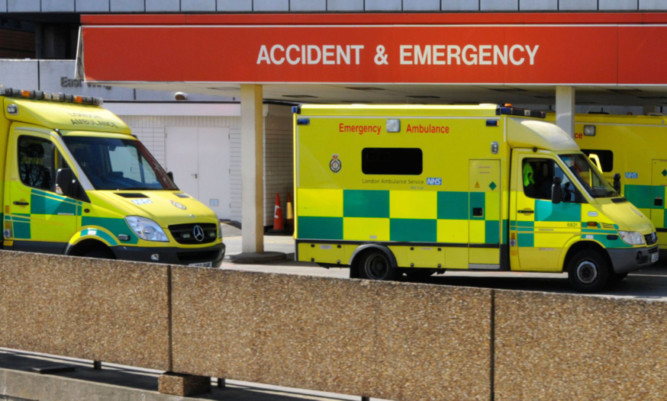
Ambulances are ferrying record numbers of patients to hospital heaping misery on swamped accident and emergency departments.
The number of journeys to A&E has soared by half a million over the past six years, hitting a high of 4.7 million last year.
The startling climb is the equivalent of an extra 230 mercy missions a day or 10 an hour across the country.
The demand is placing a huge strain on stressed paramedics, costing the NHS a fortune and leaving A&Es bursting at the seams.
More than a dozen hospitals declared “major incidents” this week, as they struggled to cope with unprecedented demand.
Shock accounts have emerged of pensioners left for 20 hours on trolleys in “war zone” wards, and one hospital even erected a tent in its car park to cope with demand.
Patients going to A&E because they cannot get an appointment to see their GP and a backlog of elderly patients blocking beds are key factors behind the crisis.
But experts say people calling ambulances when they don’t need one and a spike in the number of referrals from the 111 health advice line are fanning the flames of an inferno that is burning out of control.
Paramedic Richard Fitzgibbons, of the Association of Professional Ambulance Personnel, said crews are duty bound to respond to emergency calls.
“Calls are going up and up,” he said. “This year it has hit unprecedented levels. They have reduced A&E staff numbers and hospital beds which hasn’t helped.”
Dr Clifford Mann, president of the College of Emergency Medicine, claims the 111 line has added to the number of ambulances being dispatched unnecessarily.
By May 2014, a year after its launch, 111 call-handlers had sent 93,000 ambulances out which Dr Mann believes was excessive, blaming the computer system which the handlers use, to inform their decisions.
Paramedics say the knock-on effect of this is unmanageable workloads, low morale and a struggle to hold on to experienced staff who are leaving in their droves.
Data compiled by the Health and Social Care Information Centre revealed in 2007/8 ambulances received 7.2 million emergency and urgent calls, which resulted in paramedics attending on 5.9 million occasions.
During the year they made 4.26 million emergency patient journeys, the vast majority of which involved ferrying the sick and injured to hospital.
But by 2013/14 there were 8.47 million 999 calls, which led to paramedics attending on 6.02 million occasions and making 4.74 million emergency journeys with patients a hike of 500,000.
Mr Fitzgibbons said pressure is being heaped on the ambulance service for a host of reasons including an ageing population and excessive referrals.
He claims the workload is so great many paramedics, who earn £29,245 a year on average, are quitting the profession.
“Staff retention is a problem,” he said. “A lot of experienced staff are leaving and it is due to the stress and pressure.
“It is frustrating if you are with someone who doesn’t need an ambulance when you get a call someone is seriously ill.”
Pressure on hospitals has been growing, culminating in many declaring they were switching to emergency procedures normally reserved for incidents such as a major crash or fire with lots of casualties.
At many hospitals ambulances have queued up for hours with patients waiting to get into A&E, people have reported horrendous delays in being treated and non-urgent surgery has been postponed.
Retired teacher Richard Preston, 67, told how he spent 20 hours on a trolley in A&E at the Princess Royal University Hospital in Farnborough, Kent, in conditions he likened to a “war zone”.
He said: “There were two people to a cubicle – with a flimsy screen between them to help them try to get some sleep.
“There were elderly people calling out for help, children crying. It was terrible.”
Florence Cunningham, 81, from Fareham, Hampshire, was forced to wait 11 hours for an ambulance after collapsing at home and then a 60-minute wait to get into hospital.
Her son David said: “It was the most appalling experience. To hear my mother crying on the floor while my elderly dad was constantly getting up to look out of the window in the hope of seeing an ambulance, I will never forget.”
Meanwhile the Great Western Hospital in Swindon, Wiltshire, erected a tent in the car park to help cope with demand and cancelled all non-urgent operations.
Labour’s Shadow Health Minister Jamie Reed said patients are being put at risk as the A&E crisis worsens.
He said: “David Cameron’s failure means this is a crisis of the Government’s making. Last week was the worst in living memory in A&E.”
Jonathan Benger, National Clinical Director for Urgent Care at NHS England, said: “Crews are working extra hours to ensure patients are treated as quickly as possible.
“We’ve invested £48 million extra in ambulance services over winter to help with extra capacity and made important improvements to the way emergency system operates, ensuring more calls can now be resolved by phone, and that a larger number of patients can be treated at the scene rather than at a hospital A&E department.”
Responding to concerns about 111 Professor Keith Willett, director of acute care at NHS England added: “The proportion of callers who were referred to A&E departments and ambulances actually fell during this period and NHS 111 number played a major part in addressing patients’ needs and helping to reduce pressures on other parts of the national healthcare system.”
A Department of Health spokesperson said: “The NHS is busier than ever before, which is why we’ve given the NHS a record £700m this winter for more doctors, nurses and beds. Over Christmas 2,500 more people were seen every day within the four-hour target than in 2010.”

Enjoy the convenience of having The Sunday Post delivered as a digital ePaper straight to your smartphone, tablet or computer.
Subscribe for only £5.49 a month and enjoy all the benefits of the printed paper as a digital replica.
Subscribe